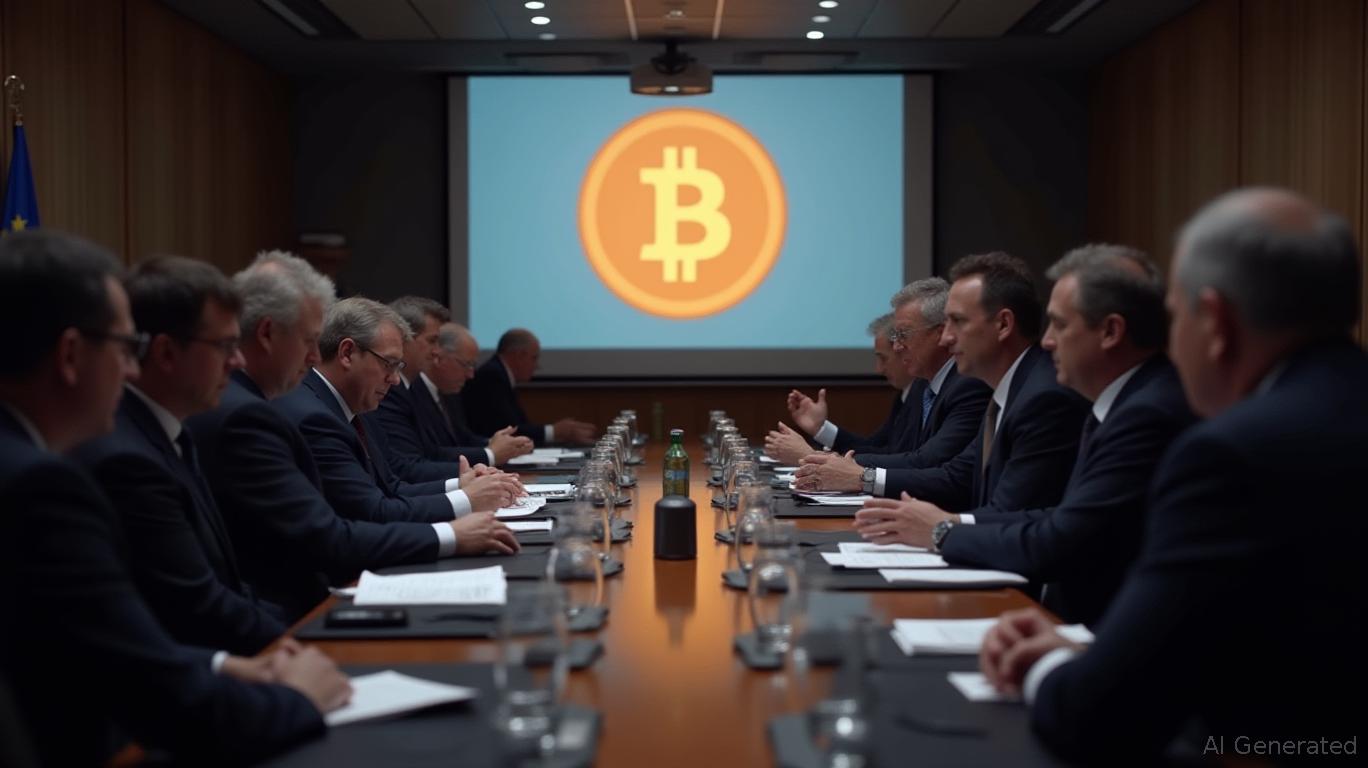Bitcoin Updates: France Challenges ECB, Supports Bitcoin Amid EU Rules Restricting Stablecoin Growth
- USDC's $76B supply growth driven by Circle's ClearBank partnership, enabling instant EUR-to-stablecoin conversions under MiCA-compliant audits. - EU regulatory clashes between MiCA and PSD2 double compliance costs, risking stablecoin adoption as France rejects ECB's digital euro in favor of BTC and euro-stablecoins. - DeFi platforms boost USDC liquidity via cross-chain integrations, but fragmented infrastructure across 15+ blockchains creates interoperability challenges. - France's 2% BTC reserve proposa
USD Coin (USDC) has reached a circulating supply of $76 billion, propelled by key alliances and multi-chain expansions that highlight its significance as a foundational element in the worldwide crypto ecosystem.

At the same time, regulatory ambiguity continues to affect the EU’s stablecoin industry. Conflicting requirements between MiCA and the Payment Services Directive (PSD2) have imposed additional compliance challenges, forcing companies to secure two separate licenses for stablecoin custody and transfer operations. Circle’s EU policy head,
France has taken a decisive approach in this environment, with legislators rejecting the European Central Bank’s digital euro initiative and instead supporting
Decentralized finance (DeFi) platforms are also influencing the evolution of stablecoins. Bybit’s adoption of native USDC transfers on Hedera’s blockchain has increased liquidity on the ESG-oriented network, with inflows rising by 25% after the announcement, as previously reported by ABC Money. Likewise, Solana’s network recently saw $750 million in USDC minted, leveraging its high-speed capabilities to support DeFi and NFT markets. However, the stablecoin landscape remains fragmented. By late 2025, USDC is available on over 15 blockchains, while USDT operates on eight, creating interoperability issues that complicate cross-chain transfers and liquidity management—a challenge discussed in an .
The so-called “stablecoin bridge problem” has become a significant challenge. Recent research has shown that having multiple token contracts for a single stablecoin—such as wrapped tokens or chain-specific versions—splits liquidity and raises security concerns. Solutions like intent-based bridging, where users define their transaction objectives without manually choosing transfer routes, are gaining popularity. Protocols such as Across are working to unify these processes, allowing for smooth cross-chain transfers while hiding technical complexities, as explored in detail in the Across blog.
As stablecoins see wider adoption—from remittances in high-inflation countries to use in institutional treasuries—the sector stands at a crucial crossroads. While regulatory progress and technological advances are fueling expansion, unresolved issues around interoperability and compliance threaten to fragment the market. With USDC’s market capitalization approaching $76 billion and DeFi platforms testing high-yield offerings like MEXC’s 600% APR BTC rewards, a .
---
Disclaimer: The content of this article solely reflects the author's opinion and does not represent the platform in any capacity. This article is not intended to serve as a reference for making investment decisions.
You may also like
YFI +1.21% Daily Returns from Automated Yield Agreements and DeFi Stability
- IO DeFi launches automated yield contracts to stabilize crypto returns via smart contracts, aiming to reduce manual intervention and address DeFi challenges like gas fees and slippage. - YFI rose 1.21% in 24 hours on Nov 15, 2025, but fell 6.38% in 7 days and 41.76% in a year, reflecting short-term volatility and long-term decline. - Technical analysis shows a bearish short-term trend, yet the 24-hour gain sparked optimism, highlighting market uncertainty and automated strategies’ potential to mitigate v
Bitcoin News Update: Major Whale Faces Uncertainty on $95M BTC Position Amid $327M in Crypto Liquidations Due to Market Volatility
- $327M in crypto positions liquidated, driven by longs as a whale buys 1,000 BTC ($95.3M) on Hyperliquid. - BTC volatility pushes price below $95K, exposing $5.52B in leveraged exposure with $159M in long losses. - Crypto slump sees $492M ETF outflows, 1.5% ETH drop, and 2.2% SOL decline amid AI stock concerns. - Tether invests €1B in German robotics firm Neura, expanding beyond stablecoins into AI and real-world assets. - Japan and UK introduce stablecoin regulations as macroeconomic uncertainty amplifie

Bitcoin News Today: Harvard Invests $442M in IBIT—Traditional Finance Turns to Bitcoin for Portfolio Diversification
- Harvard triples stake in BlackRock's IBIT to $442.8M, becoming top institutional holder. - Bitcoin ETFs attract $60.8B in inflows since 2024, with BlackRock's IBIT dominating the market. - Harvard's move reflects institutional shift toward crypto as inflation hedge despite volatility. - Analysts highlight Bitcoin's scarcity and regulatory clarity as key drivers for portfolio diversification. - Brown University and others may follow, signaling broader adoption of Bitcoin ETFs.
Solana News Update: Solana ETFs Attract $370 Million Despite 34% Price Drop—Institutional Optimism Defies Negative Sentiment
- Solana ETFs attracted $370M in 13 days despite 34% price drop, driven by Bitwise and Grayscale products. - Institutional inflows contrasted broader crypto outflows as technical indicators signaled bearish sentiment below $140. - NYSE launched Solana ETF options, intensifying altcoin ETF competition with VanEck's regulatory filings. - Diverging ETF demand and price weakness raised sustainability concerns amid declining retail enthusiasm.
